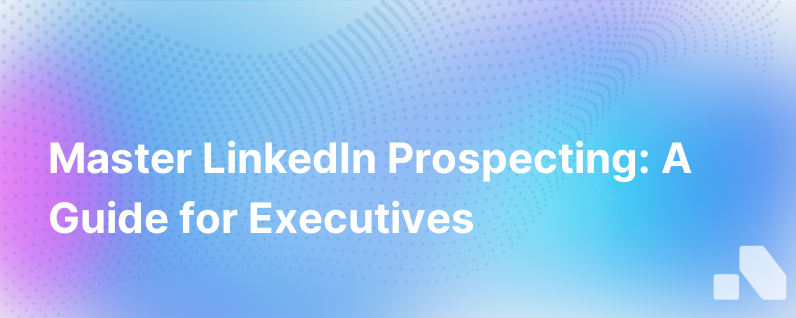
In the vast ocean of professional networking, LinkedIn stands out as a significant vessel for B2B prospecting. For businesses, particularly those in the B2B sphere, LinkedIn has revolutionized the way sales professionals connect with potential clients and decision-makers. Yet, despite LinkedIn's potential as a powerful prospecting tool, not all who navigate its waters do so effectively. To truly harness the platform’s capabilities requires a strategic approach towards LinkedIn prospecting.
In this guide, we'll plot a course through the intricacies of LinkedIn prospecting, ensuring your outreach efforts are not just shots in the dark but well-targeted maneuvers based on insightful data and genuine relationship-building.
Setting the Stage for Successful LinkedIn Prospecting
Before diving deep into LinkedIn’s networking pool, it’s crucial to get your own profile in shipshape. A polished, professional LinkedIn profile is your first impression — it should be as impactful as a firm handshake and a keen eye contact in a traditional meeting setting. Make sure your profile is complete with a professional photo, concise yet compelling summary, detailed work experience, and recommendations that endorse your credibility.
With your profile primed, move on to crafting a prospecting plan. This plan should involve understanding your target audience, creating a list of ideal customer personas, and researching the common pain points and interests of these prospects. Audience insights will later inform how you personalize your connection requests and messages for a higher response rate.
Navigating the LinkedIn Prospecting Seas
1. Advanced Search and Sales Navigator
Begin by utilizing LinkedIn's robust search capabilities. The platform's Advanced Search feature can filter prospects by location, industry, current company, past company, and even non-profit interests, amongst many other criteria. However, if your sails are set towards more premium waters, LinkedIn Sales Navigator is an advanced tool offering deeper insights and more precise targeting tools, aiding you in identifying and engaging with the most promising prospects.
2. Growing a Relevant Network
Start by connecting with individuals you already know — colleagues, past clients, and industry peers. Beyond first-degree connections, embark on expanding your network to include second-degree connections, which often have higher acceptance rates for new connection requests given the mutual contacts.
When reaching out to these potential leads, avoid generic connection requests. Reference a shared connection, a recent post they’ve shared, or a common interest to create a personalized touchpoint. Personalized messages are the harpoons in your prospecting arsenal; used adeptly, they captivate attention and begin conversations.
3. Sharing and Engaging with Content
Visibility on LinkedIn is significantly heightened by regularly sharing and engaging with content. By posting articles, infographics, industry insights, and company updates, you position yourself as a thought leader. Comment on and share posts from your target audience as well. This not only increases your visibility but also shows you’re keeping up with industry discourse and are open to engaging in meaningful conversations.
4. LinkedIn Groups
One of LinkedIn’s most underutilized prospecting tools is LinkedIn Groups. Groups unite professionals with common interests, companies, or industries, and offer a treasure trove of networking opportunities. Join relevant groups, contribute to discussions, and showcase your expertise without a sales pitch. This low-pressure environment can nurture relationships that may mature into solid leads.
5. Creating and Leveraging Warm Introductions
Leverage your existing connections for warm introductions. A warm introduction from a mutual contact boosts your credibility and can open doors that cold outreach cannot. Use LinkedIn to view shared connections and request introductions with context and purpose.
Navigating LinkedIn's Algorithm for Enhanced Visibility
Understanding how LinkedIn's algorithm ranks and presents content can also enhance your prospecting efforts. The algorithm rewards engagement and relevance. Engage with your prospects' content promptly, and provide thoughtful commentary to increase the likelihood that your content will appear in their feeds.
Additionally, timing is vital in capturing your audience's attention. Posting during business hours, generally Tuesday through Thursday, can potentially increase visibility for your published content, leading to more engagement.
Monitoring and Analyzing Prospect Activity
Direct messages and InMails should be approached with the same degree of personalization and relevance as your connection requests. Pay attention to the content your prospects interact with — their likes, comments, and shares provide actionable insights into their interests and needs.
To ensure that none of your efforts go unnoticed, it’s essential to monitor prospect activity. Utilize LinkedIn’s notification system to keep track of job changes, work anniversaries, and other notable events within your network. Congratulate prospects on their achievements to keep the conversation flowing and top add a personable touch to your interactions.
Following Up — The Key to Unlocking LinkedIn Prospecting's Full Potential
Send follow-up messages if there’s no response to your initial outreach, but avoid being overly persistent. Timing your follow-ups is an art: too soon may seem pushy, but too late could mean missing an opportunity. As a rule of thumb, wait for a week or two before following up. If you provide value at each interaction, your patience and professionalism will likely be rewarded.
In the long game of LinkedIn prospecting, persistence and consistency are your best mates. By consistently engaging, sharing valuable content, and maintaining an active presence, you keep your network alive and informed of your expertise and services.
Conclusion
LinkedIn prospecting is not a one-size-fits-all endeavor. It demands strategy, personalization, and an investment of time to truly understand and connect with potential clients. For businesses eyeing sustained growth, mastering LinkedIn prospecting can very well be the key to unlocking new opportunities and fostering valuable professional relationships.